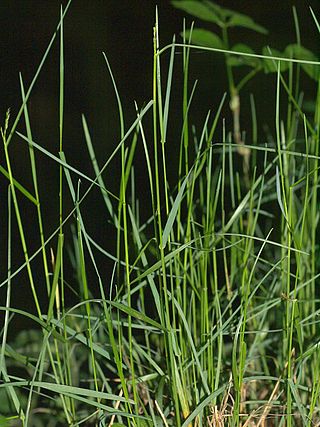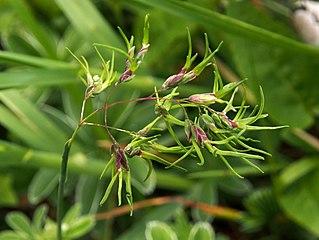
Poa pratensis, commonly known as Kentucky bluegrass, smooth meadow-grass, or common meadow-grass, is a perennial species of grass native to practically all of Europe, North Asia and the mountains of Algeria and Morocco. There is disagreement about its native status in North America, with some sources considering it native and others stating the Spanish Empire brought the seeds of Kentucky bluegrass to the New World in mixtures with other grasses. It is a common and incredibly popular lawn grass in North America with the species being spread over all of the cool, humid parts of the United States. In its native range, Poa pratensis forms a valuable pasture plant, characteristic of well-drained, fertile soil. It is also used for making lawns in parks and gardens and has established itself as a common invasive weed across cool moist temperate climates like the Pacific Northwest and the Northeastern United States. When found on native grasslands in Canada, for example, it is considered an unwelcome exotic plant, and is indicative of a disturbed and degraded landscape.

Poa is a genus of about 570 species of grasses, native to the temperate regions of both hemispheres. Common names include meadow-grass, bluegrass, tussock, and speargrass. Poa is Greek for 'fodder'. Poa are members of the subfamily Pooideae of the family Poaceae.

Molinia, or moor grass, is a genus of two species of flowering plants in the grass family, native to damp moorland in Eurasia and northern Africa. They are both herbaceous perennial grasses.

Poa nemoralis, the wood bluegrass, is a perennial plant in the family Poaceae. The late-growing grass is fairly nutritious for livestock, which feed on it in the autumn, and it is used as a lawn grass for shady situations.
Micromeria imbricata var. imbricata is a variety of flowering plant in the family Lamiaceae, native to Africa and the Arabian Peninsula. Under the synonym Micromeria remota it was assessed as "least concern" when considered endemic to Socotra.

Tussock grasses or bunch grasses are a group of grass species in the family Poaceae. They usually grow as singular plants in clumps, tufts, hummocks, or bunches, rather than forming a sod or lawn, in meadows, grasslands, and prairies. As perennial plants, most species live more than one season. Tussock grasses are often found as forage in pastures and ornamental grasses in gardens.
Poa triodioides, synonyms including Austrofestuca littoralis, is a species of flowering plant in the grass family Poaceae, native to southwestern and southeastern Australia and to New Zealand.

Poa alpina, commonly known as alpine meadow-grass or alpine bluegrass, is a species of grass with a primarily holarctic distribution.

Elachista apicipunctella is a moth of the family Elachistidae found in Europe. It is found in all of Europe, east into northern Russia.

Poa foliosa is a species of tussock grass commonly known as muttonbird poa. It is native to the subantarctic islands of New Zealand and Australia.

Elachista adscitella is a moth of the family Elachistidae found in Europe.

Charles-Joseph Marie Pitard, name sometimes given as Charles-Joseph Marie Pitard-Briau was a French pharmacist and botanist.

Spermacoce remota, the woodland false buttonweed, is a species of plant in the Rubiaceae. It is native to the southeastern United States, West Indies, Mexico, Central America and South America. It is naturalized in Taiwan, Southeast Asia, China (Guangdong), India, Sri Lanka, New Guinea, Mauritius and many other oceanic islands.
Poa fordeana is a grass native to Australia which is found in New South Wales, Victoria, South Australia and Queensland.

Poa drummondiana is a perennial herb in the Poaceae family.

Carex remota, the remote sedge, is a species in the genus Carex, native to Europe, the Atlas Mountains in Africa, and western Asia. It is a riparian forest specialist. It is known as one of the most frequently hybridizing species of Carex, forming hybrids with C. appropinquata, C. arenaria, C. brizoides, C. canescens, C. divulsa, C. echinata, C. elongata, C. leporina, C. otrubae, C. paniculata, and C. spicata.

Poa supina is a species of flowering plant belonging to the family Poaceae.
Poa humilis is a species of flowering plant belonging to the family Poaceae.

Poa angustifolia is a species of flowering plant belonging to the family Poaceae.

Poa cita, commonly known as the silver tussock, or wī, which is also a Māori name, or by the Māori name pātītī, is a grass of the family Poaceae that is endemic to New Zealand. Poa cita was described and named by Elizabeth Edgar in 1986, having previously being named Poa caespitosa.
















